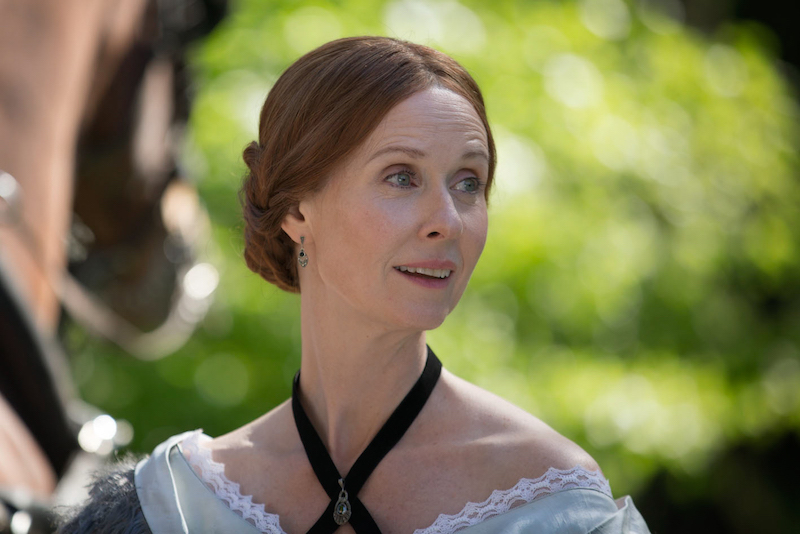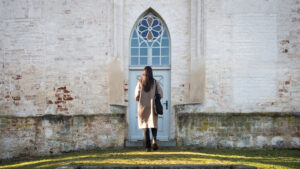A Quiet Passion, director Terence Davies’s new film based on the life of poet Emily Dickinson, is a great deal like Dickinson’s poems: fragmentary, intense, dark, humorous, and sharply punctuated. Despite some notable flaws—the delivery of many lines is more suited for stage than camera, and lead actor Cynthia Nixon’s frequent Cheshire cat smile is jarring—A Quiet Passion is a rich film, in every sense of the word.
It won’t be to everyone’s taste, but it’s exquisitely done. As one reviewer explains it, the form reflects Dickinson’s own aesthetic: “Just as Dickinson’s poetic mode of personal expression and ear for idiosyncratic metaphor anticipated modernism, so here does Davies’s cinematic style slip certain bonds and achieve an unquiet fluidity.” Like Dickinson’s poems, the film luxuriates in the tangibles of life, tokens resonant with human meaning.
Film About Life
In this way, A Quiet Passion is, perhaps, as much about what life is like as it is about what Dickinson’s life was like. Life is filled with many quiet moments—alone or with family and friends, at the table, in the parlor, around the yard, in the midst of conversation. Life is filled with contradictions in our words, in our actions, in our inner thoughts and beliefs. The power of the film is in capturing the way these moments accumulate into life’s most meaningful things, just as Dickinson captured them in her poetry.
With languishing camera pans across interior doors and walls, creative renderings of the passage of time, lush period settings, disjointed and stylized dialogue—all set against a backdrop of exquisite and eclectic musical selections (including a piano rendition of a number from Spamalot, which, oddly enough, works perfectly)—the film is more experimental than conventional. In fact, watching A Quiet Passion is less like watching a movie and more like walking through a museum to gaze at a well-curated but eccentric series of skillful paintings.
Although the narrative arc covers the span of Dickinson’s life, it’s not a film for viewers desiring a complete and coherent picture of a life, or the conventional biographical emphases one might expect. As with Dickinson’s poems, much is left out, much is merely hinted, and much is lingered on that most of us would prefer to not even think about.
Like death.
Film About Death
The film captures powerfully why the poet most famous for the lines “Because I could not stop for Death, he kindly stopped for me” was so obsessed with death. Since death is much less a part of our lives than it was for those in Dickinson’s era, it’s easy for us to judge as morbid what was then closer to normal. A Quiet Passion dwells excruciatingly on scenes of death and suffering—not exploitatively, but humanly. The scene of Dickinson’s mother’s death is both painful and beautiful in its mere humanity. The intensity of the film’s physical suffering—that of Emily, her mother, and less so her sister-in-law—is superseded by its portrayal of the family’s deep love for one another through all their pains—physical, spiritual, and emotional.
Film About Love
Similarly, the intensity of the love depicted in A Quiet Passion—of father for daughter, mother for children, sister for brother, friend for friend—is, I think, like none other I’ve ever seen on screen. It’s not your typical, Hollywood-style passion—glossy, melodramatic, self-indulgent, and predictable. It’s much more like that of real people living real lives that are messy and hard and yet filled with hope, hope less for oneself than for their beloved.
Film About Faith
The film’s backdrop of the Civil War is a helpful reminder of the reasons behind the racial tensions and inequities that still reverberate today. That war is also emblematic of the spiritual war that seemed to rage within Dickinson for her entire life. She was the 19th-century prototype for the “spiritual not religious” impulse that was shocking then, but standard today. As she quips in one poem quoted in the film:
Some keep the Sabbath going to church
I keep it staying at home.
Indeed, A Quiet Passion opens, using some poetic license, with a scene depicting Dickinson’s rejection of the severe evangelistic approach of Mount Holyoke College. There she was a female seminarian for less than a year before returning permanently home, where she’d eventually become a recluse.

The religious oppression that defined Dickinson’s life—echoed by her oppression in being a woman—is, aptly, a heavy theme in the film. Big, bad religious people are among the most clichéd of tropes in modern filmmaking. But that doesn’t mean the stereotype has no truth. Nor does it mean devout Christians don’t have something to learn from those who reject the oft-tyranny of the overly pietistic.
We who live to share the truth of the gospel with all, and through every means, could learn much from this Dickinson poem, one of my favorites:
Tell all the truth but tell it slant
Success in Circuit lies
Too bright for our infirm Delight
The Truth’s superb surprise
As Lightning to the Children eased
With explanation kind
The Truth must dazzle gradually
Or every man be blind
All the evidence of Dickinson’s life, letters, and poems suggest someone whose religious sensibility was serious, genuine, and intense, even as her soul shrank under the pressing thumb of institutional Christianity. Yet much of her poetry, such as this one, portrays Dickinson’s real faith in faith:
Faith—is the Pierless Bridge
Supporting what We see
Unto the Scene that We do not
Director Terence Davies’s task of selecting but a representative few of the 1,800 poems Dickinson wrote (all but a handful published after her death) was difficult, but he chose well. As the film draws to a close with Dickinson’s death in 1886 at age 55, we hear lines from a poem that well reflects Dickinson’s view of religion and faith. It’s laden with truth as resonant for us today as for the Belle of Amherst so long ago:
This World is not Conclusion.
A Species stands beyond
Invisible, as Music
But positive, as Sound
It beckons, and it baffles
Philosophy, don’t know
And through a Riddle, at the last
Sagacity, must go
To guess it, puzzles scholars
To gain it, Men have borne
Contempt of Generations
And Crucifixion, shown
Faith slips – and laughs, and rallies
Blushes, if any see
Plucks at a twig of Evidence
And asks a Vane, the way
Much Gesture, from the Pulpit
Strong Hallelujahs roll
Narcotics cannot still the Tooth
That nibbles at the soul
Dickinson doubted God, religion, ministers, and marriage. But she doubted none of these more than she doubted herself. Despite this, her life and poetry suggest nothing could entirely still the Christian faith that nibbled at her soul.
Try Before You Buy: FREE Sample of TGC’s New Advent Devotional

Choosing the right Advent daily devotional can be tough when there are so many options. We want to make it easier for you by giving you a FREE sample of TGC’s brand-new Advent devotional today.
Unto Us is designed to help you ponder the many meanings of this season. Written by TGC staff, it offers daily Scripture readings, reflections, and questions to ponder. We’ll send you a free sample of the first five days so you can try it out before purchasing it for yourself or your church.
































